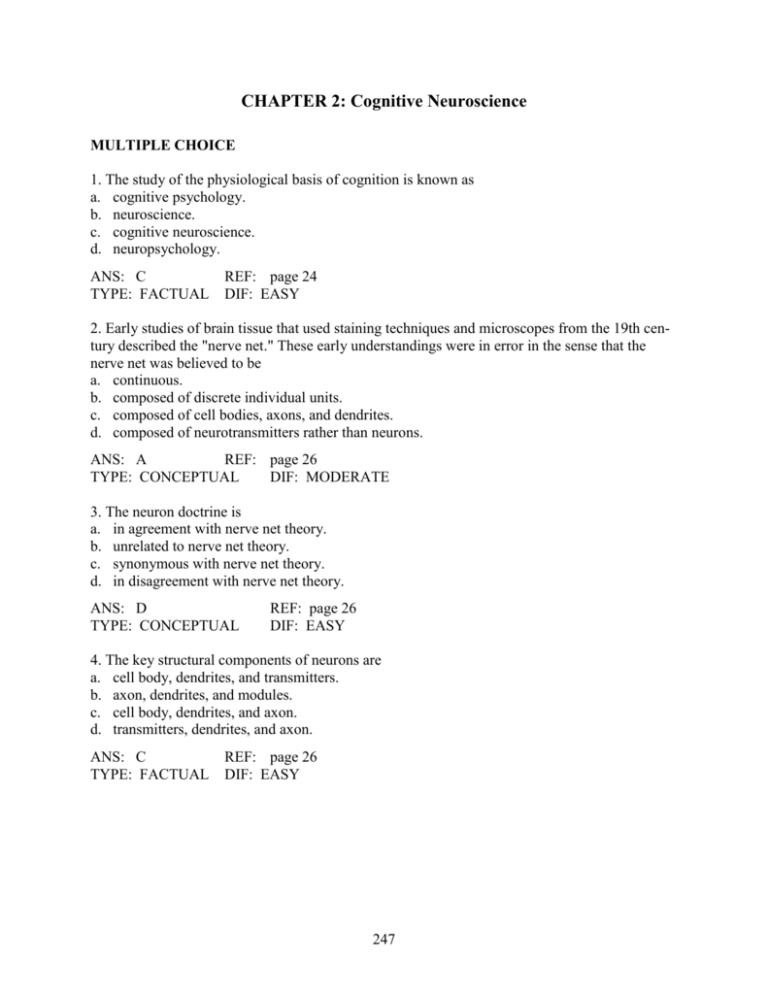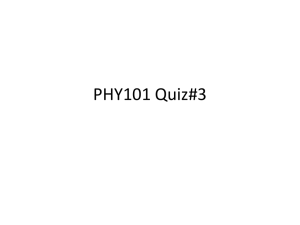Free Sample
advertisement

CHAPTER 2: Cognitive Neuroscience MULTIPLE CHOICE 1. The study of the physiological basis of cognition is known as a. cognitive psychology. b. neuroscience. c. cognitive neuroscience. d. neuropsychology. ANS: C TYPE: FACTUAL REF: page 24 DIF: EASY 2. Early studies of brain tissue that used staining techniques and microscopes from the 19th century described the "nerve net." These early understandings were in error in the sense that the nerve net was believed to be a. continuous. b. composed of discrete individual units. c. composed of cell bodies, axons, and dendrites. d. composed of neurotransmitters rather than neurons. ANS: A REF: page 26 TYPE: CONCEPTUAL DIF: MODERATE 3. The neuron doctrine is a. in agreement with nerve net theory. b. unrelated to nerve net theory. c. synonymous with nerve net theory. d. in disagreement with nerve net theory. ANS: D TYPE: CONCEPTUAL REF: page 26 DIF: EASY 4. The key structural components of neurons are a. cell body, dendrites, and transmitters. b. axon, dendrites, and modules. c. cell body, dendrites, and axon. d. transmitters, dendrites, and axon. ANS: C TYPE: FACTUAL REF: page 26 DIF: EASY 247 5. Which of the following neural components is NOT found at the receiving end of neurons? a. Cell body b. Dendrite c. Receptor d. Axon ANS: D TYPE: CONCEPTUAL REF: page 26 DIF: MODERATE 6. A synapse is a. a tube filled with fluid that conducts electrical signals. b. the structure that contains mechanisms to keep a neuron alive. c. the structure that receives electrical signals from other neurons. d. the space between neurons. ANS: D TYPE: FACTUAL REF: page 27 DIF: EASY 7. Neural circuits are groups of interconnected neurons that a. have only excitatory synapses. b. have only inhibitory synapses. c. can result in a neuron that responds best to a specific stimulus. d. are primarily responsible for automatic behaviors, like reflexes. ANS: C TYPE: CONCEPTUAL REF: page 27 DIF: MODERATE WWW 8. Action potentials occur in the a. cell body. b. synapse. c. neurotransmitters. d. axon. ANS: D TYPE: FACTUAL REF: page 28 DIF: MODERATE 9. Recordings from single neurons are conducted using which of these pieces of equipment? a. Positron emission tomography scanner b. Functional magnetic resonance imaging scanner c. Microelectrode d. Neurotransmitter ANS: C TYPE: FACTUAL REF: page 28 DIF: MODERATE 248 10. An oscilloscope can display "spikes" that correspond to nerve impulses in response to a certain stimulus intensity. If the stimulus intensity is decreased, you are likely to observe spikes that are a. less frequent and smaller in size. b. less frequent and of the same size. c. as frequent and smaller in size. d. the same signal as with the higher stimulus intensity. ANS: B TYPE: APPLIED REF: page 28 DIF: DIFFICULT 11. If the intensity of a stimulus that is presented to a touch receptor is increased, this tends to increase the _____ in the receptor’s axon. a. rate of nerve firing b. size of the nerve impulses c. speed of nerve conduction d. all of these ANS: A TYPE: APPLIED REF: page 29 KEY: WWW DIF: MODERATE 12. When recording from a single neuron, stimulus intensity is represented in a single neuron by the a. size of the action potentials. b. size of the synapse. c. firing rate of the neurotransmitters. d. firing rate of the action potentials. ANS: D TYPE: FACTUAL REF: page 29 DIF: MODERATE 13. Which of the following statements best describes how neurons communicate with one another? a. The end of one neuron makes direct contact with the receiving end of another neuron. b. A chemical process takes place at the synapse. c. An electrical process takes place in the receptors. d. Action potentials travel across the synapse. ANS: B TYPE: CONCEPTUAL REF: page 29 DIF: DIFFICULT 14. Which of the following is consistent with the idea of localization of function? a. Specific areas of the brain serve different functions. b. Neurons in different areas of the brain respond best to different stimuli. c. Brain areas are specialized for specific functions. d. All of these ANS: D TYPE: CONCEPTUAL REF: pages 29-30 DIF: MODERATE 249 15. Recording from single neurons in the brain has shown that neurons responding to specific types of stimuli are often clustered in specific areas. These results support the idea of a. cortical association. b. dissociation. c. localization of function. d. the information processing approach. ANS: C TYPE: APPLIED REF: pages 29-30 DIF: EASY 16. The temporal lobe is a. the first place in the cerebral cortex where visual information is received. b. important for language, memory, hearing, and vision. c. important for higher functions such as language, thought, and memory, as well as motor functioning. d. where signals are received from the auditory system. ANS: D TYPE: FACTUAL REF: page 30 DIF: EASY 17. The occipital lobe is a. the first place in the cerebral cortex where visual information is received. b. important for language, memory, hearing, and vision. c. important for higher functions such as language, thought, and memory, as well as motor functioning. d. where signals are received from the sensory system for touch. ANS: A TYPE: FACTUAL REF: page 30 DIF: EASY 18. The _____ lobe of the cortex serves higher functions such as language, thought, and memory. a. subcortical b. frontal c. occipital d. parietal ANS: B TYPE: FACTUAL REF: page 30 DIF: EASY 19. Which part of the brain is important for touch? a. Occipital lobe b. Hippocampus c. Temporal lobe d. Parietal lobe ANS: D TYPE: FACTUAL REF: page 30 KEY: WWW DIF: MODERATE 250 20. A 10-month-old baby is interested in discovering different textures, comparing the touch sensations between a soft blanket and a hard wooden block. Tactile signals such as these are received by the _____ lobe. a. parietal b. occipital c. frontal d. temporal ANS: A TYPE: APPLIED REF: page 30 DIF: MODERATE 21. Positron emission tomography (PET) utilizes which of the following tools? a. Disc electrode b. Microelectrode c. Radioactive tracer d. Hemoglobin ANS: C TYPE: CONCEPTUAL REF: page 31 DIF: MODERATE 22. There are many methods for studying the physiology of the brain. ________ is the technique involving subtraction whereby brain activity is compared between baseline and stimulation measurements. a. Convergence b. Single unit recording c. Positron emission tomography d. Mental chronometry ANS: C TYPE: CONCEPTUAL REF: page 31 DIF: MODERATE 23. Brain-imaging techniques can determine all of the following EXCEPT a. areas of the brain activated during cognitive tasks. b. localization of brain activity in response to a specific stimulus. c. the structure of individual neurons. d. patterns of blood flow in the brain. ANS: C TYPE: CONCEPTUAL REF: pages 31-32 DIF: MODERATE KEY: WWW 24. Brain imaging has made it possible to a. determine which areas of the brain are involved in different cognitive processes. b. view individual neurons in the brain. c. show how environmental energy is transformed into neural energy. d. view propagation of action potentials. ANS: A TYPE: APPLIED REF: pages 31-32 DIF: MODERATE 251 25. Hemoglobin molecules in areas of high brain activity a. gain some of the ferrous molecules they are transporting. b. lose some of the ferrous molecules they are transporting. c. gain some of the oxygen they are transporting. d. lose some of the oxygen they are transporting. ANS: D TYPE: CONCEPTUAL REF: page 32 DIF: DIFFICULT 26. Which of the following do PET and fMRI have in common? a. The use of the subtraction technique b. The measurement of magnetic fields c. The use of radioactive tracers d. All of the above are characteristics of both PET and fMRI ANS: A TYPE: CONCEPTUAL REF: page 32 DIF: DIFFICULT 27. The fusiform face area (FFA) in the brain is often damaged in patients with a. Broca's aphasia. b. Wernicke's aphasia. c. prosopagnosia. d. Alzheimer's disease. ANS: C TYPE: CONCEPTUAL REF: page 32 DIF: MODERATE 28. Sarah has experienced brain damage making it difficult for her to understand spatial layout. Which area of her brain has most likely sustained damage? a. Fusiform face area (FFA) b. Parahippocampal place area (PPA) c. Extrastriate body area (EBA) d. Functional magnetic area (FMA) ANS: B TYPE: APPLIED REF: page 32 DIF: MODERATE 29. Ramon is looking at pictures of scantily clad women in a magazine. He is focusing on their body parts, particularly their chest and legs. Which part of Ramon's brain is activated by this viewing? a. Fusiform face area (FFA) b. Parahippocampal place area (PPA) c. Extrastriate body area (EBA) d. Functional magnetic area (FMA) ANS: C TYPE: APPLIED REF: page 32 DIF: MODERATE 252 30. Josiah is trying to speak to his wife, but his speech is very slow and labored, often with jumbled sentence structure. Josiah may have damage to his a. Broca's area. b. Parahippocampal place area (PPA) c. Extrastriate body area (EBA) d. Wernicke's area. ANS: A TYPE: APPLIED REF: page 33 DIF: MODERATE 31. Damage to Wernicke's area is in which lobe of the brain? a. Temporal b. Occipital c. Parietal d. Frontal ANS: A TYPE: CONCEPTUAL REF: page 33 DIF: MODERATE 32. Paul Broca's and Carl Wernicke's research provided early evidence for a. distributed processing. b. localization of function. c. prosopagnosia. d. neural net theory. ANS: B TYPE: CONCEPTUAL REF: page 33 DIF: EASY 33. Recent research on language has modified our earlier understanding of Broca's aphasia such that it is now understood as a problem in a. language production but not understanding. b. language production but not meaning. c. language form but not meaning. d. language meaning but not form. ANS: C TYPE: CONCEPTUAL REF: page 34 DIF: MODERATE 34. Compared to brain-imaging techniques, ERP occurs on a a. much slower time scale. b. similar time scale. c. much faster time scale. d. more precise scale for understanding which brain structures are active. ANS: C TYPE: CONCEPTUAL REF: page 34 DIF: MODERATE 253 35. In ERP methodology, the number that follows the N or the P (N400 or P300, for example) stands for a. the positivity or negativity of the response. b. how likely the response is, with higher numbers indicating a more likely response. c. how strong the response is in millimeters on the reading. d. the time at which the response peaks in milliseconds. ANS: D TYPE: FACTUAL REF: page 35 DIF: MODERATE 36. Research using the ERP method shows that damage to the frontal lobes reduces the larger response that occurs when the form of a sentence is incorrect. a. N100 b. N400 c. P300 d. P600 ANS: D TYPE: APPLIED REF: page 35 DIF: DIFFICULT 37. The idea that specific functions are processed in many parts of the brain is known as a. localization of function. b. distributed processing. c. modularity. d. aphasia. ANS: B TYPE: FACTUAL REF: page 36 DIF: EASY 38. You are walking down the street and see a really nice car drive by. You notice many features of it: its color, movement, shape, location, and so forth. All of these features are processed a. in one localized area of the brain. b. by the grandmother cells in the brain. c. in different parts of the brain. d. through fMRI potentials. ANS: C TYPE: APPLIED REF: page 37 DIF: MODERATE 39. The layer of neurons that lines the back of the eye is called the a. retina. b. grandmother cell. c. reference electrode. d. feature detector. ANS: A TYPE: FACTUAL REF: page 38 DIF: EASY 254 40. Neurons that respond to features that make up objects are called a. retinal cells. b. feature detectors. c. dendrites. d. receptors. ANS: B TYPE: FACTUAL REF: page 38 DIF: EASY 41. The pattern of feature detectors firing in response to a stimulus creates the ing what the stimulus is (e.g., a tree, a person, a ball, and so forth). a. neural code b. module c. event-related potential d. receptor ANS: A TYPE: FACTUAL for represent- REF: page 39 DIF: MODERATE 42. The way patterns of neural firing represent a specific stimulus or experience is known as a. the action potential. b. a propagated signal. c. convergence. d. the neural code. ANS: D TYPE: FACTUAL REF: page 39 DIF: MODERATE 43. If kittens are raised in an environment that contains only verticals, you would predict that most of the neurons in their visual cortex would respond best to the visual presentation of a a. brick wall. b. chain link fence. c. solid wall. d. picket fence. ANS: D TYPE: APPLIED REF: page 39 DIF: MODERATE 44. The idea of a grandmother cell is consistent with a. distributed coding. b. specificity coding. c. subtraction techniques. d. primary receiving areas. ANS: B TYPE: CONCEPTUAL REF: pages 39-40 DIF: EASY 255 45. A grandmother cell responds a. only to a specific stimulus. b. to strong positive emotion. c. to both positive and negative emotion. d. to a variety of stimuli. ANS: A TYPE: FACTUAL REF: page 40 DIF: MODERATE 46. When conducting an experiment on how stimuli are represented by the firing of neurons, you notice that neurons respond differently to different faces. For example, Arthur's face causes three neurons to fire, with neuron 1 responding the most and neuron 3 responding the least. Roger's face causes the same three neurons to fire, with neuron 1 responding the least and neuron 3 responding the most. Your results support ____ coding. a. specificity b. distributed c. convergence d. divergence ANS: B TYPE: APPLIED REF: page 40 DIF: MODERATE 47. The concept of distributed neural coding proposes that a specific object, like a face, is represented across a number of a. microelectrodes. b. stimuli. c. modalities. d. neurons. ANS: D TYPE: FACTUAL REF: page 40 DIF: EASY 48. A specific person’s face is represented in the nervous system by the firing of a. a feature detector that fires specifically to that face. b. a group of neurons that all respond only to that face. c. a group of neurons each responding to a number of different faces. d. a receptor in the retina that responds when the face is present. ANS: C TYPE: APPLIED REF: page 40 KEY: WWW DIF: MODERATE 49. Most cognitive psychologists a. accept b. are uncertain about c. reject d. are actively investigating ANS: C TYPE: APPLIED the notion of a grandmother cell. REF: page 40 KEY: WWW DIF: MODERATE 256 50. Shinkareva et al. (2008) conducted research that revealed a. the existence of feature detectors. b. the distinction between form and meaning in language. c. a computer could fairly accurately predict what category of object one was viewing. d. strong support for specificity coding. ANS: C TYPE: FACTUAL REF: pages 42-43 KEY: WWW DIF: MODERATE ESSAY 1. Describe how neurons communicate. Mention the key components of the neurons that are involved. Explain the process whereby the electrical signal (the information) is transferred from one neuron to another. ANS: REF: pages 25-29 2. Explain how action potentials change in response to stimulus intensity. Use examples from two sensory modalities to illustrate this process. ANS: REF: pages 29 KEY: WWW 3. Describe three physiological techniques for investigating human cognition. What can each technique tell us about the brain and human cognition? Also, give at least one limitation of each of the three techniques. ANS: REF: pages 30-32, 34 4. Describe how localization of function and distributed brain activity work together in everyday cognitive processes. Use the example of seeing your prom date at a high school reunion to illustrate your answer. ANS: REF: pages 33-37 5. Explain the purpose of feature detectors in creating mental representation of objects. ANS: REF: pages 38-39 KEY: WWW 257







